Among the tropical Liliaceae families, the Gloriosa are so gracious that Linne wished to emphasize the beauty of its flowers by using the term “gloriosa”. By the same token, it is this beauty that caused the Lao to name these flowers phan maha – literally translated, “the thousand grandeurs”, which can be interpreted as, “the million splendours”.
These climbing, bulbous shrubs originate from Africa and Southeast Asia; they like the coastal regions, but can also be found deep in the interior of areas such as Thailand, from where the botanists believe the Gloriosa superba to have originated.
This “lily”, which the French call “Malabar”, from the name of an ancient part of India, climbs trees to a height of about three or four metres, thanks to the strong tendrils that extend from its leaves. Its single flowers at the axilla of its leaves are divided in six long, straight petals, tapered and curly, rippled at the ends at first, they are yellow, then turn scarlet and bend towards the top. They are surrounded at their base by six long stamens; the whole flower giving the impression of elegance and lightness. The fruits are thick, oval, dehiscent capsules, containing three segments of seeds, which turn red when ripe.
The lily of Malabar is as dangerous as it is beautiful. In fact, if humans ingest its tubers, it causes serious poisoning. The plant contains two alkaloids, one of which, colchicine, induces severe gastro-enteritis, vomiting, and, sometimes, a state of unconsciousness. In Laos, some cases of intoxication have been cited due to the confusion of the rhizome of this ‘false lily’ with that of ginger.
But like all toxic plants, there are “strong” plants that have medicinal qualities. Thus, leaves that can, by contact, cause acute itching, are, in Africa, used to treat asthma attacks. In the ancient sanskrit texts where it is referred to as “that which aborts”, the lily of Malabar is rarely or never given internally, but is used to facilitate expulsion of the placenta, and in Laos it is found to induce abortions. In Africa, the grated rhizome is used to get rid of lice; in Laos, it is used to kill dogs.
The pharmaceutical industry employs colchicine and its derivatives in the preparation of anti-inflammatory and anti-rheumatic medications.
Parmi les Liliacées tropicales, les Gloriosa sont si gracieux que Linné, avec le terme « gloriosa », voulut souligner la beauté de ces fleurs. C’est cette beauté également que le lao retient qui nomme ces fleurs phan maha, littéralement « les mille grandeurs » que l’on peut interpréter comme « les mille splendeurs ».
Ces plantes grimpantes arbustives à bulbes sont originaires d’Afrique et d’Asie du Sud Est; elles affectionnent les régions côtières, mais on les rencontre aussi, loin à l’intérieur des terres comme en Thaïlande d’où les botanistes considèrent que Gloriosa superba est originaire.
Ce « lys » que le français nomme de « Malabar » du nom d’une ancienne région de l’Inde, grimpe sur les arbres jusqu’à 3 ou 4 mètres grâce aux vrilles puissantes qui prolongent les feuilles. Ses fleurs solitaires à l’aisselle des feuilles sont découpées en 6 longs pétales étroits, effilés et tirebouchonnés, à la marge ondulée, d’abord jaunes, devenant ensuite rouges écarlates et se recourbant vers le haut. Ils sont entourés à la base de 6 longues étamines, l’ensemble donnant l’impression d’élégance et de légèreté. Les fruits sont des capsules coriaces ovoïdes, déhiscentes à 3 loges pourvues de graines rouges à maturité.
Le lys de Malabar est tout aussi dangereux qu’il est beau. En effet, chez les humains, l’ingestion des tubercules produit une intoxication grave. La plante contient deux alcaloïdes dont la colchicine, qui provoque une gastro-entérite sévère, des vomissements et parfois un état d’inconscience. On cite au Laos quelques cas d’intoxication dus à la confusion du rhizome de ce faux lys avec celui du gingembre.
Mais comme les plantes toxiques sont des plantes « fortes », elles ont des vertus médicinales. Ainsi les feuilles qui peuvent, par contact, causer des démangeaisons aigues, sont, en Afrique, employées pour traiter les crises d’asthme. Dans les textes sanscrits anciens où il est nommé “celui qui avorte” le lys de Malabar est rarement ou jamais donné en usage interne mais utilisé pour faciliter l’expulsion du placenta et l’on retrouve cet usage au Laos pour déclencher des avortements. Les râpures de rhizome qui, en Afrique, éliminent les poux, au Laos tuent les chiens.
L’industrie pharmaceutique emploie la colchicine et ses dérivés dans la préparation de médicaments anti-inflammatoires et anti rhumatismaux.
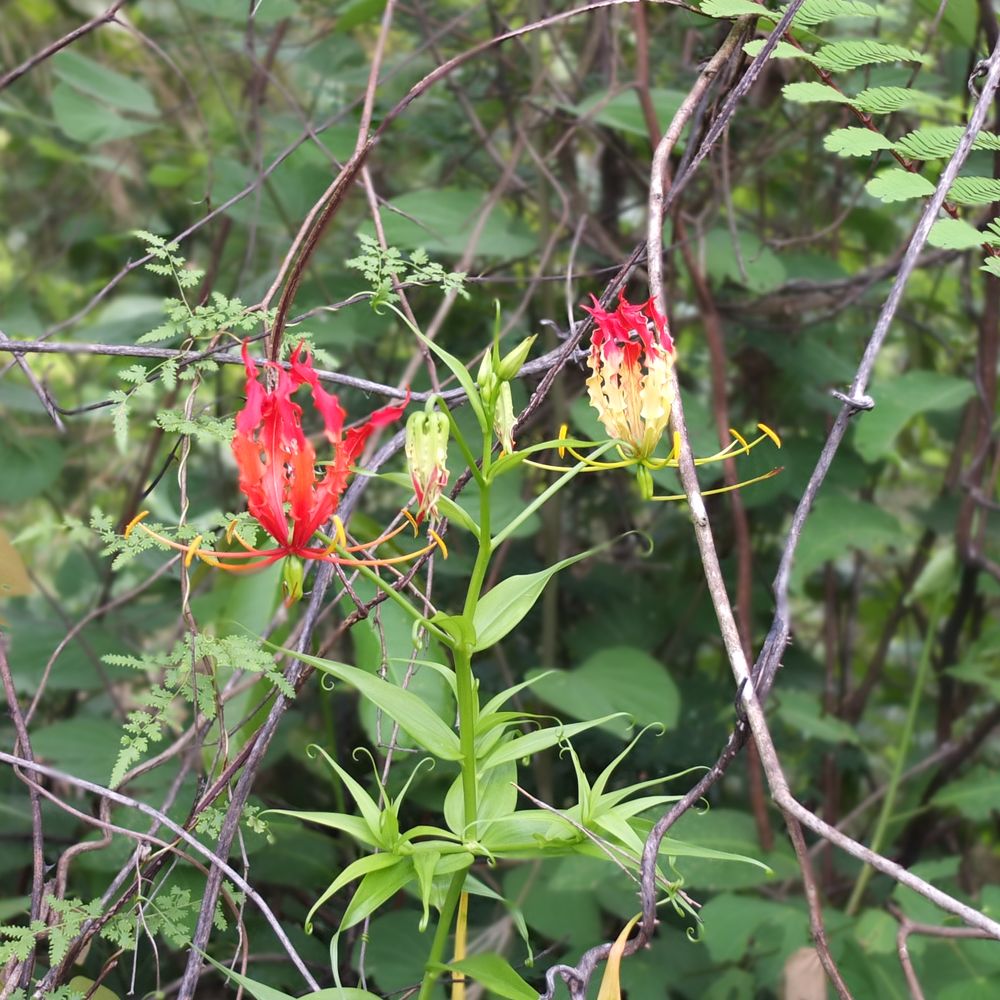
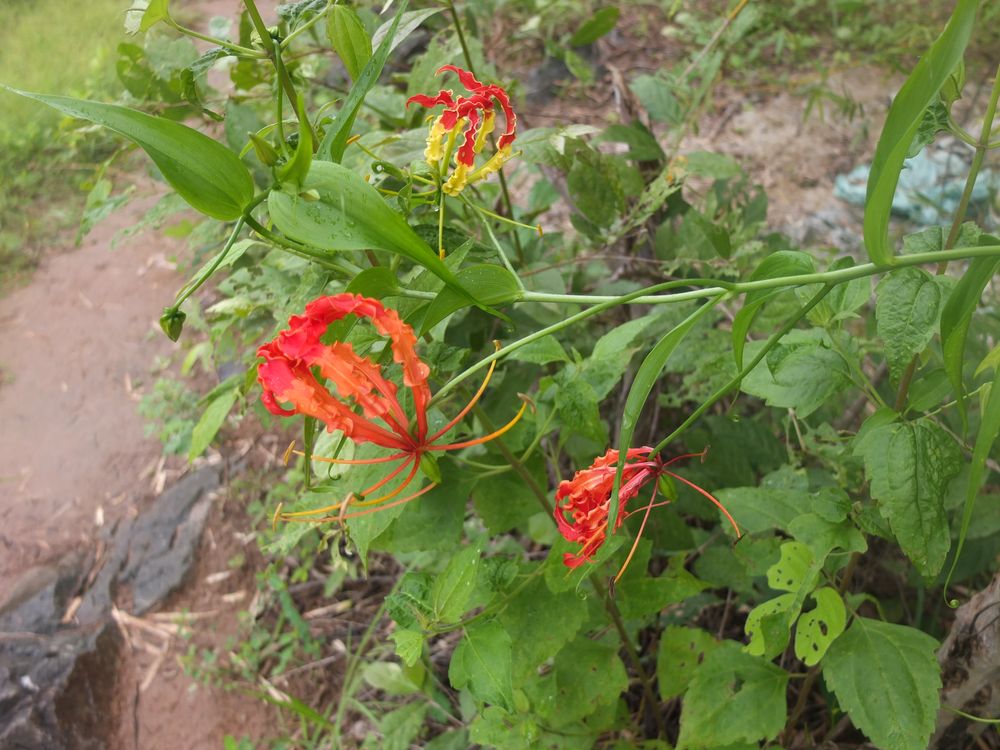
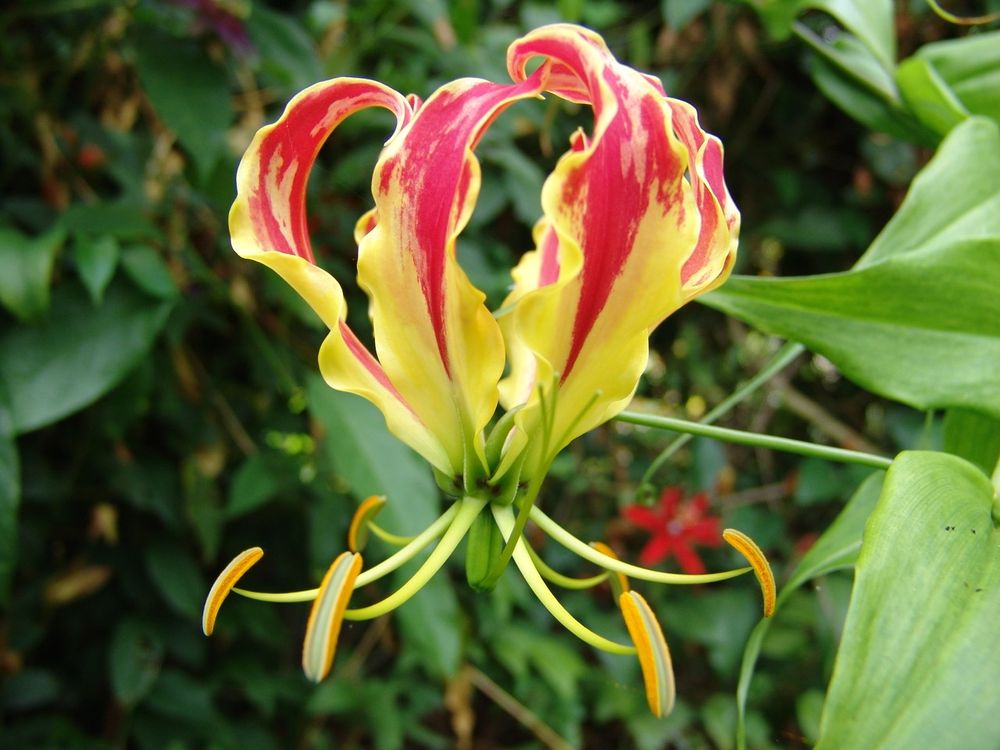
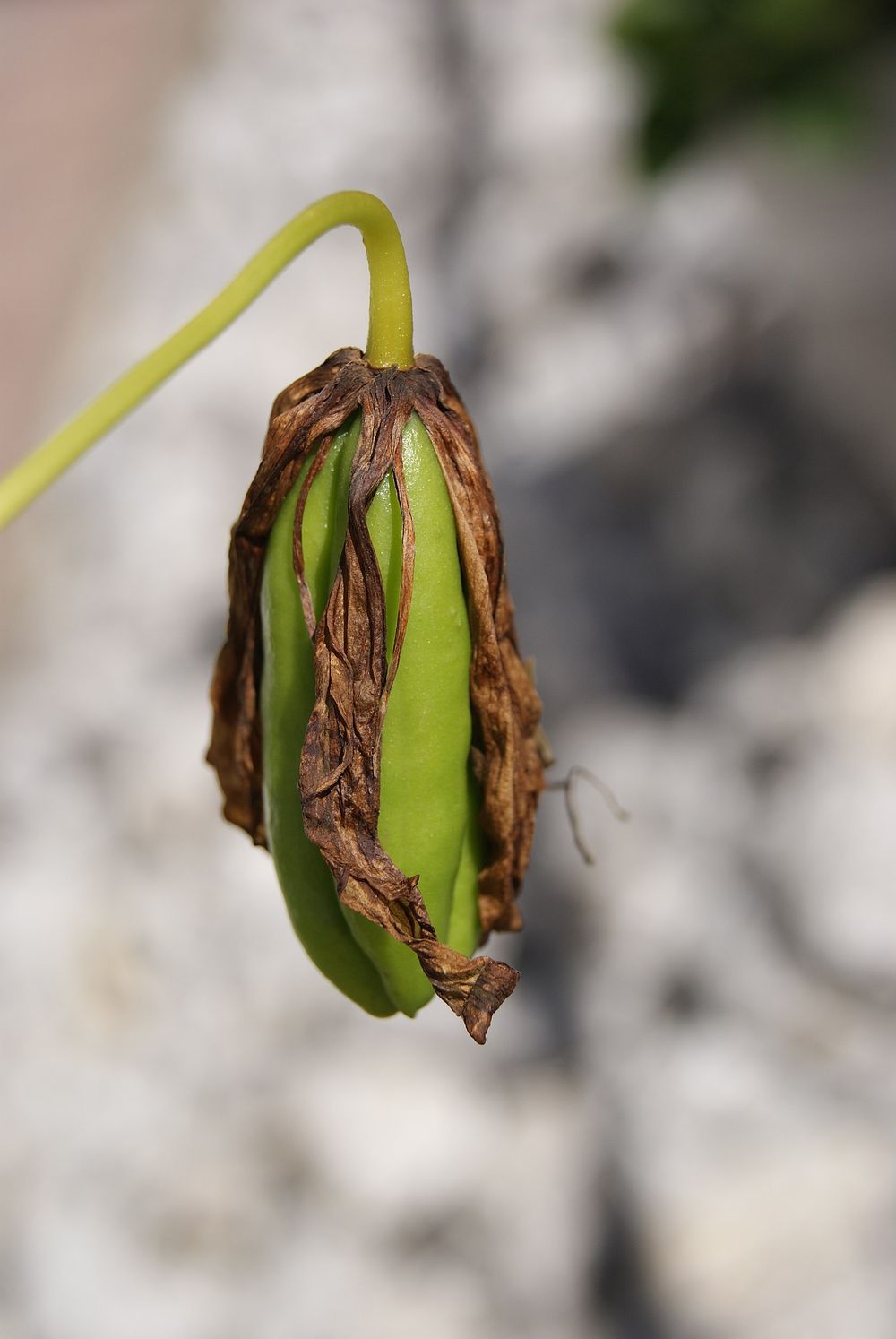
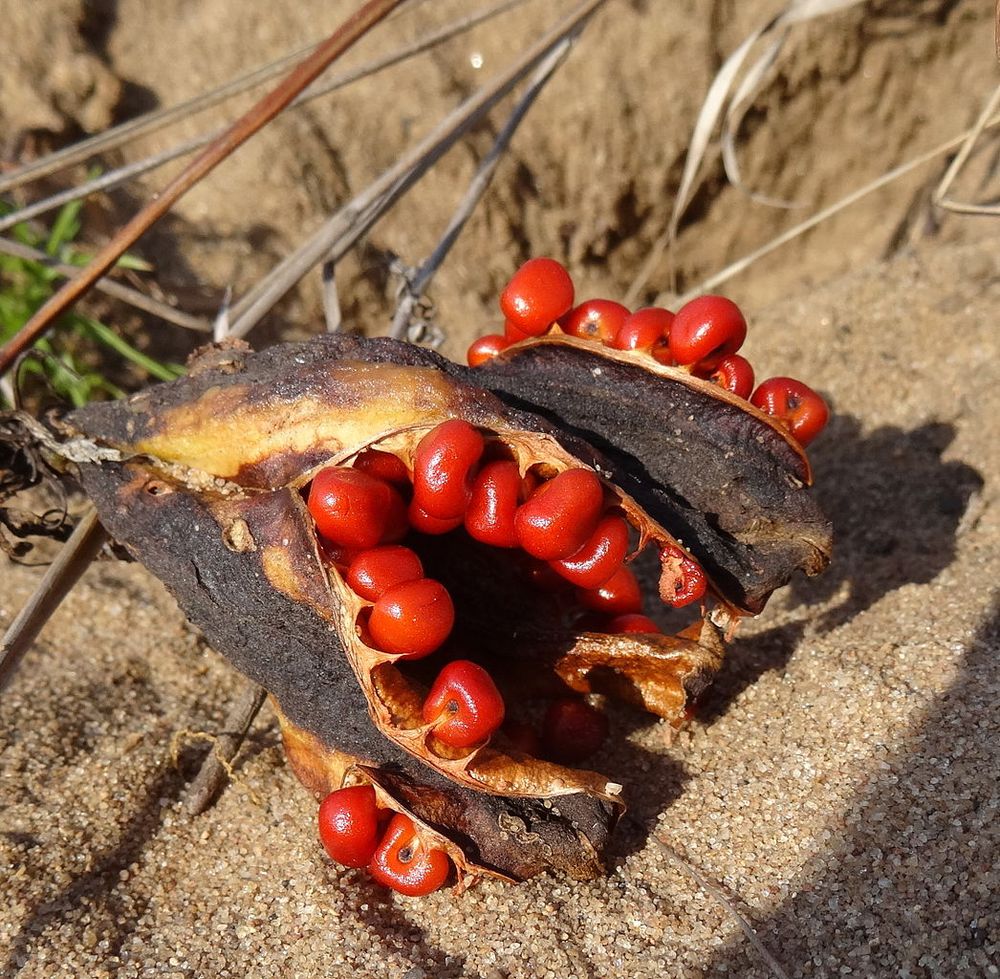
Among the tropical Liliaceae families, the Gloriosa are so gracious that Linne wished to emphasize the beauty of its flowers by using the term “gloriosa”. By the same token, it is this beauty that caused the Lao to name these flowers phan maha – literally translated, “the thousand grandeurs”, which can be interpreted as, “the million splendours”.
These climbing, bulbous shrubs originate from Africa and Southeast Asia; they like the coastal regions, but can also be found deep in the interior of areas such as Thailand, from where the botanists believe the Gloriosa superba to have originated.
This “lily”, which the French call “Malabar”, from the name of an ancient part of India, climbs trees to a height of about three or four metres, thanks to the strong tendrils that extend from its leaves. Its single flowers at the axilla of its leaves are divided in six long, straight petals, tapered and curly, rippled at the ends at first, they are yellow, then turn scarlet and bend towards the top. They are surrounded at their base by six long stamens; the whole flower giving the impression of elegance and lightness. The fruits are thick, oval, dehiscent capsules, containing three segments of seeds, which turn red when ripe.
The lily of Malabar is as dangerous as it is beautiful. In fact, if humans ingest its tubers, it causes serious poisoning. The plant contains two alkaloids, one of which, colchicine, induces severe gastro-enteritis, vomiting, and, sometimes, a state of unconsciousness. In Laos, some cases of intoxication have been cited due to the confusion of the rhizome of this ‘false lily’ with that of ginger.
But like all toxic plants, there are “strong” plants that have medicinal qualities. Thus, leaves that can, by contact, cause acute itching, are, in Africa, used to treat asthma attacks. In the ancient sanskrit texts where it is referred to as “that which aborts”, the lily of Malabar is rarely or never given internally, but is used to facilitate expulsion of the placenta, and in Laos it is found to induce abortions. In Africa, the grated rhizome is used to get rid of lice; in Laos, it is used to kill dogs.
The pharmaceutical industry employs colchicine and its derivatives in the preparation of anti-inflammatory and anti-rheumatic medications.
Parmi les Liliacées tropicales, les Gloriosa sont si gracieux que Linné, avec le terme « gloriosa », voulut souligner la beauté de ces fleurs. C’est cette beauté également que le lao retient qui nomme ces fleurs phan maha, littéralement « les mille grandeurs » que l’on peut interpréter comme « les mille splendeurs ».
Ces plantes grimpantes arbustives à bulbes sont originaires d’Afrique et d’Asie du Sud Est; elles affectionnent les régions côtières, mais on les rencontre aussi, loin à l’intérieur des terres comme en Thaïlande d’où les botanistes considèrent que Gloriosa superba est originaire.
Ce « lys » que le français nomme de « Malabar » du nom d’une ancienne région de l’Inde, grimpe sur les arbres jusqu’à 3 ou 4 mètres grâce aux vrilles puissantes qui prolongent les feuilles. Ses fleurs solitaires à l’aisselle des feuilles sont découpées en 6 longs pétales étroits, effilés et tirebouchonnés, à la marge ondulée, d’abord jaunes, devenant ensuite rouges écarlates et se recourbant vers le haut. Ils sont entourés à la base de 6 longues étamines, l’ensemble donnant l’impression d’élégance et de légèreté. Les fruits sont des capsules coriaces ovoïdes, déhiscentes à 3 loges pourvues de graines rouges à maturité.
Le lys de Malabar est tout aussi dangereux qu’il est beau. En effet, chez les humains, l’ingestion des tubercules produit une intoxication grave. La plante contient deux alcaloïdes dont la colchicine, qui provoque une gastro-entérite sévère, des vomissements et parfois un état d’inconscience. On cite au Laos quelques cas d’intoxication dus à la confusion du rhizome de ce faux lys avec celui du gingembre.
Mais comme les plantes toxiques sont des plantes « fortes », elles ont des vertus médicinales. Ainsi les feuilles qui peuvent, par contact, causer des démangeaisons aigues, sont, en Afrique, employées pour traiter les crises d’asthme. Dans les textes sanscrits anciens où il est nommé “celui qui avorte” le lys de Malabar est rarement ou jamais donné en usage interne mais utilisé pour faciliter l’expulsion du placenta et l’on retrouve cet usage au Laos pour déclencher des avortements. Les râpures de rhizome qui, en Afrique, éliminent les poux, au Laos tuent les chiens.
L’industrie pharmaceutique emploie la colchicine et ses dérivés dans la préparation de médicaments anti-inflammatoires et anti rhumatismaux.










Among the tropical Liliaceae families, the Gloriosa are so gracious that Linne wished to emphasize the beauty of its flowers by using the term “gloriosa”. By the same token, it is this beauty that caused the Lao to name these flowers phan maha – literally translated, “the thousand grandeurs”, which can be interpreted as, “the million splendours”.
These climbing, bulbous shrubs originate from Africa and Southeast Asia; they like the coastal regions, but can also be found deep in the interior of areas such as Thailand, from where the botanists believe the Gloriosa superba to have originated.
This “lily”, which the French call “Malabar”, from the name of an ancient part of India, climbs trees to a height of about three or four metres, thanks to the strong tendrils that extend from its leaves. Its single flowers at the axilla of its leaves are divided in six long, straight petals, tapered and curly, rippled at the ends at first, they are yellow, then turn scarlet and bend towards the top. They are surrounded at their base by six long stamens; the whole flower giving the impression of elegance and lightness. The fruits are thick, oval, dehiscent capsules, containing three segments of seeds, which turn red when ripe.
The lily of Malabar is as dangerous as it is beautiful. In fact, if humans ingest its tubers, it causes serious poisoning. The plant contains two alkaloids, one of which, colchicine, induces severe gastro-enteritis, vomiting, and, sometimes, a state of unconsciousness. In Laos, some cases of intoxication have been cited due to the confusion of the rhizome of this ‘false lily’ with that of ginger.
But like all toxic plants, there are “strong” plants that have medicinal qualities. Thus, leaves that can, by contact, cause acute itching, are, in Africa, used to treat asthma attacks. In the ancient sanskrit texts where it is referred to as “that which aborts”, the lily of Malabar is rarely or never given internally, but is used to facilitate expulsion of the placenta, and in Laos it is found to induce abortions. In Africa, the grated rhizome is used to get rid of lice; in Laos, it is used to kill dogs.
The pharmaceutical industry employs colchicine and its derivatives in the preparation of anti-inflammatory and anti-rheumatic medications.
Parmi les Liliacées tropicales, les Gloriosa sont si gracieux que Linné, avec le terme « gloriosa », voulut souligner la beauté de ces fleurs. C’est cette beauté également que le lao retient qui nomme ces fleurs phan maha, littéralement « les mille grandeurs » que l’on peut interpréter comme « les mille splendeurs ».
Ces plantes grimpantes arbustives à bulbes sont originaires d’Afrique et d’Asie du Sud Est; elles affectionnent les régions côtières, mais on les rencontre aussi, loin à l’intérieur des terres comme en Thaïlande d’où les botanistes considèrent que Gloriosa superba est originaire.
Ce « lys » que le français nomme de « Malabar » du nom d’une ancienne région de l’Inde, grimpe sur les arbres jusqu’à 3 ou 4 mètres grâce aux vrilles puissantes qui prolongent les feuilles. Ses fleurs solitaires à l’aisselle des feuilles sont découpées en 6 longs pétales étroits, effilés et tirebouchonnés, à la marge ondulée, d’abord jaunes, devenant ensuite rouges écarlates et se recourbant vers le haut. Ils sont entourés à la base de 6 longues étamines, l’ensemble donnant l’impression d’élégance et de légèreté. Les fruits sont des capsules coriaces ovoïdes, déhiscentes à 3 loges pourvues de graines rouges à maturité.
Le lys de Malabar est tout aussi dangereux qu’il est beau. En effet, chez les humains, l’ingestion des tubercules produit une intoxication grave. La plante contient deux alcaloïdes dont la colchicine, qui provoque une gastro-entérite sévère, des vomissements et parfois un état d’inconscience. On cite au Laos quelques cas d’intoxication dus à la confusion du rhizome de ce faux lys avec celui du gingembre.
Mais comme les plantes toxiques sont des plantes « fortes », elles ont des vertus médicinales. Ainsi les feuilles qui peuvent, par contact, causer des démangeaisons aigues, sont, en Afrique, employées pour traiter les crises d’asthme. Dans les textes sanscrits anciens où il est nommé “celui qui avorte” le lys de Malabar est rarement ou jamais donné en usage interne mais utilisé pour faciliter l’expulsion du placenta et l’on retrouve cet usage au Laos pour déclencher des avortements. Les râpures de rhizome qui, en Afrique, éliminent les poux, au Laos tuent les chiens.
L’industrie pharmaceutique emploie la colchicine et ses dérivés dans la préparation de médicaments anti-inflammatoires et anti rhumatismaux.


